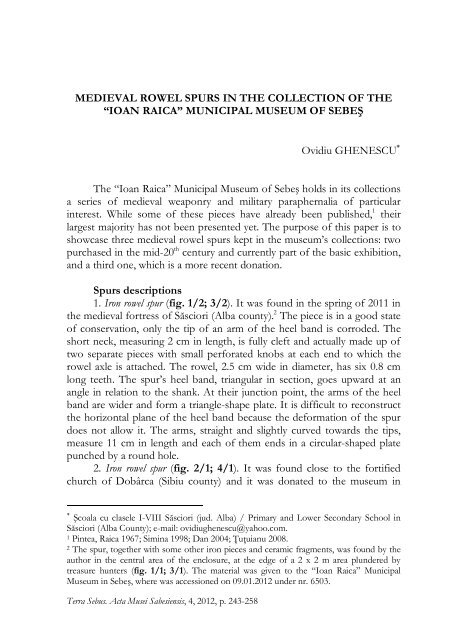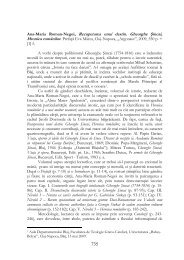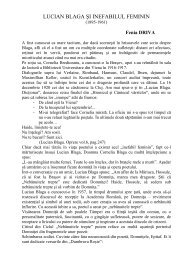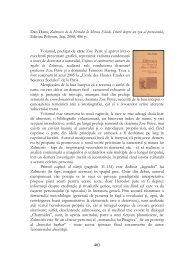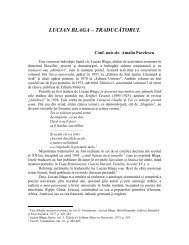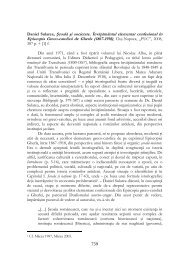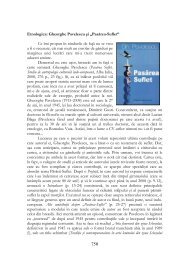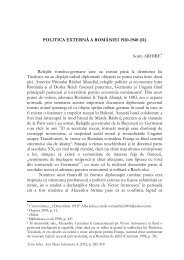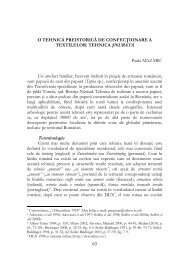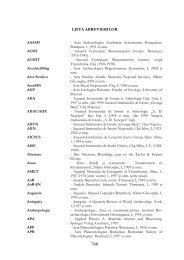MEDIEVAL ROWEL SPURS IN THE COLLECTION OF THE “IOAN ...
MEDIEVAL ROWEL SPURS IN THE COLLECTION OF THE “IOAN ...
MEDIEVAL ROWEL SPURS IN THE COLLECTION OF THE “IOAN ...
You also want an ePaper? Increase the reach of your titles
YUMPU automatically turns print PDFs into web optimized ePapers that Google loves.
<strong>MEDIEVAL</strong> <strong>ROWEL</strong> <strong>SPURS</strong> <strong>IN</strong> <strong>THE</strong> <strong>COLLECTION</strong> <strong>OF</strong> <strong>THE</strong><br />
<strong>“IOAN</strong> RAICA” MUNICIPAL MUSEUM <strong>OF</strong> SEBEŞ<br />
Terra Sebus. Acta Musei Sabesiensis, 4, 2012, p. 243-258<br />
Ovidiu GHENESCU �<br />
The “Ioan Raica” Municipal Museum of Sebeş holds in its collections<br />
a series of medieval weaponry and military paraphernalia of particular<br />
interest. While some of these pieces have already been published, 1 their<br />
largest majority has not been presented yet. The purpose of this paper is to<br />
showcase three medieval rowel spurs kept in the museum’s collections: two<br />
purchased in the mid-20 th century and currently part of the basic exhibition,<br />
and a third one, which is a more recent donation.<br />
Spurs descriptions<br />
1. Iron rowel spur (fig. 1/2; 3/2). It was found in the spring of 2011 in<br />
the medieval fortress of Săsciori (Alba county). 2 The piece is in a good state<br />
of conservation, only the tip of an arm of the heel band is corroded. The<br />
short neck, measuring 2 cm in length, is fully cleft and actually made up of<br />
two separate pieces with small perforated knobs at each end to which the<br />
rowel axle is attached. The rowel, 2.5 cm wide in diameter, has six 0.8 cm<br />
long teeth. The spur’s heel band, triangular in section, goes upward at an<br />
angle in relation to the shank. At their junction point, the arms of the heel<br />
band are wider and form a triangle-shape plate. It is difficult to reconstruct<br />
the horizontal plane of the heel band because the deformation of the spur<br />
does not allow it. The arms, straight and slightly curved towards the tips,<br />
measure 11 cm in length and each of them ends in a circular-shaped plate<br />
punched by a round hole.<br />
2. Iron rowel spur (fig. 2/1; 4/1). It was found close to the fortified<br />
church of Dobârca (Sibiu county) and it was donated to the museum in<br />
� Şcoala cu clasele I-VIII Săsciori (jud. Alba) / Primary and Lower Secondary School in<br />
Săsciori (Alba County); e-mail: ovidiughenescu@yahoo.com.<br />
1 Pintea, Raica 1967; Simina 1998; Dan 2004; Ţuţuianu 2008.<br />
2 The spur, together with some other iron pieces and ceramic fragments, was found by the<br />
author in the central area of the enclosure, at the edge of a 2 x 2 m area plundered by<br />
treasure hunters (fig. 1/1; 3/1). The material was given to the “Ioan Raica” Municipal<br />
Museum in Sebeş, where was accessioned on 09.01.2012 under nr. 6503.
Ovidiu Ghenescu<br />
Sebeş in 1968 by primary school teacher Schmidt from Dobârca. 3 The piece<br />
is in a poor state of conservation, both shank and rowel being strongly<br />
corroded. The oval shaped shank tapers towards the tip, measures 4.2 cm in<br />
length and approximately half of it (2.2 cm) is cleft to hold the rowel. The<br />
tips are shaped into small perforated knobs to which the rowel axle is<br />
attached. The now strongly corroded rowel apparently used to have eight<br />
teeth, the maximum known length of a teeth being 1 cm. The rowel is<br />
approximately 3 cm wide in diameter. The arms of the heel band are<br />
semioval in section, on the same axis with the shank and slightly curved<br />
upwards. The arms are slightly wider at their junction point. The maximum<br />
length of the arms is 12 cm and their spread is max. 9 cm. The arms end in<br />
a rectangular-shaped plate with rounded edges and two round holes.<br />
3. Iron rowel spur (fig. 2/2; 4/2). Unknown findspot. Previously kept<br />
in the old collection of the German Gymnasium in Sebeş, it went into the<br />
museum collection at the end of 1957, the year the institution was founded. 4<br />
The spur is in a pretty poor state of conservation, both the shank and the<br />
rowel are corroded. The oval shank with an overall length of 5.3 cm, tapers<br />
to the tip and is vertically oblique to the arms. A 3.1 cm-long stretch of it (a<br />
little more than half its total length) is cleft to hold the rowel. The tips of<br />
the shank thicken into small perforated knobs to which the rowel axle is<br />
attached. The rowel initially had six teeth out of which five still exist, it is<br />
3.2 cm wide in diameter and the length a tooth is approximately 1 cm. Small<br />
bumps are alternately arranged between the rowel teeth and most probably<br />
represent another 6 atrophied teeth. The arms of the heel band are semioval<br />
in section, and shaped like a pointed arch to the horizontal axis. The arms<br />
are slightly wider at their junction point. The maximum length of the arms<br />
is 9 cm, and their spread is max. 8.1 cm. The arms end in a rectangularshaped<br />
plate with rounded edges and two round holes. Two hooks, one for<br />
each perforation, are attached to one of the arms and one hook at the other<br />
arm. The hooks are shaped like the letter S with closed ends, are between 3-<br />
3.6 cm long and 0.2-0.3 thick. The central part of the hooks is flattened off<br />
in the shape of round pills with a diameter of 1.2-1.4 cm.<br />
3 The piece was accessioned on 03.01.1968 under nr. 4210 marked in white paint on one of<br />
the arms. Although the accession records say “spurs” from Dobârca, it is highly unlikely to<br />
have been more than one piece, standing proof thereof is the single accession number.<br />
4 The piece was recorded in the accession book of the museum in Sebeş on 5.12.1957<br />
under nr. 78. The same number is marked in white paint on one of the arms, although the<br />
record specifies the marked number is 247. It is however impossible to be a different spur<br />
as our item matches the description in the museum records entirely.<br />
244
Medieval Rowel Spurs in the Collection of the “Ioan Raica” Municipal Museum of Sebeş<br />
Dating and historical considerations<br />
Rowel spurs appear in 13 th century Europe as a revolutionary<br />
innovation in a knight’s riding aids. During this century rowel spurs were<br />
used alongside the previous spur type, the prick spur, which ended their<br />
evolution by early 14 th century.<br />
It is not known wherefrom rowel spurs originated. Iconographic<br />
sources of the early 13 th century show the more or less simultaneous<br />
appearance of rowel spurs in the German, 5 French, English and Italian<br />
geographical areas. 6 Until the end of the 13 th century they spread almost<br />
throughout Europe. However, it appears that the new fashion reached the<br />
Italian and Spanish areas with more difficulty and became popular only in<br />
the 14 th century. 7<br />
The earliest types of rowel spurs inherit the shape of the heel band<br />
and the strapping systems of the 12 th -13 th century prick spurs. As an element<br />
of novelty, the shank holding the rowel is short and fully cleft. Such pieces<br />
were subsumed by Al. Ruttkay to the C type dated to the first half of the<br />
13 th century until the mid-14 century. In the Russian space, the earliest types<br />
of rowel spurs were dated before the Mongol invasion of 1240 and were<br />
included by A. N. Kirpičnikov in the V type. 8 Similar pieces discovered on<br />
Hungarian territory were associated by G. Nagy to the Angevine era. 9<br />
In Transylvania, such early spurs with short, fully cleft shank, were<br />
grouped by Z. Györfi into four main types A.a.1, A.b.1, A.c.1 and B.a.1. 10<br />
The rowel spur discovered in the fortress of Săsciori, by the shape of the<br />
arms, belongs to the type A.a.1. in Z. Györfi’s typology 11 and to the type Cb<br />
in Al. Ruttkay’s. 12 Most Transylvanian pieces subsumed to this type,<br />
however, do not have discovery contexts to enable a more accurate dating.<br />
Consequently, the spurs found the fortress of Măgura Codlei were loosely<br />
dated, based on analogies with similar pieces, to the 13 th -14 th centuries. 13 We<br />
5 Ruttkay 1976, p. 351.<br />
6 Ellis, Egan 1995, p. 128.<br />
7 Ruttkay 1976, p. 351.<br />
8 Kirpičnikov 1973, fig. 37.<br />
9 Nagy 1898, p. 62; for an overview of the main systems for spur classification, see<br />
Jakovljević 2009, p. 109-112.<br />
10 Györfi 2004, p. 102-106; Györfi 2006, p. 102-106.<br />
11 Györfi 2004, p. 102-103; Györfi 2006, p. 102-103; to the repertoire published by Zalán<br />
Györfi another spur found in the fortress of Tilişca could be added (Nägler 1967, p. 82,<br />
Abb. 2/2) and, possibly, the one discovered at the Comana fortress (Eskenasy 1981, p. 39,<br />
fig. 12). The spur from Cluj Napoca-Astoria Hotel, seems to belong to a more advanced<br />
type due to its elongated, partially split, shank (Mitrofan 1965, p. 660, fig. 5/1).<br />
12 Ruttkay 1976, p. 350-352, Abb. 72.<br />
13 Costea 1968, p. 82, fig. 7.<br />
245
Ovidiu Ghenescu<br />
know nothing of the archeological context the spurs from the Piatra Craivii<br />
fortress dated to the 13 th -14 th centuries, 14 or the ones of Tăuţi dated to the<br />
14 th century, were found. 15 Three published spurs found in enclosures I and<br />
II of Dăbâca in the level corresponding to the stone enclosure, were loosely<br />
dated to the 14 th -15 th centuries. 16 The spurs found in the fortress of Tilişca<br />
in an unknown context were dated based on typological criteria to the 14 th -<br />
15 th centuries. 17 The piece from Voivodeni was part of the inventory of a<br />
partially revealed dwelling loosely dated to the 12 th -14 th centuries. 18 The spur<br />
belonging to the same type found by chance or during fieldwalking at<br />
Cernat were dated base on analogies to the 14 th century. 19 Also following<br />
some field investigations the spur from Jigodin dated to the 14 th -15 th<br />
centuries, was discovered. 20 The spurs kept in the collection of the National<br />
Museum of Transylvanian History, one discovered at Cluj-Napoca –<br />
Franciscan Church and the other two of unknown findspot, are in a similar<br />
situation. 21<br />
Furthermore, there are a few finds that give us precious clues to the<br />
dating of this type of piece from Transylvania. Thus, one of the spurs<br />
discovered at Cecheşti was found in a waste pit along 13 th century ceramic<br />
material. 22 The piece of Chilieni belonged to a dwelling, also dated to the<br />
13 th century, having in its inventory clay pails. 23 Inside the keep found in<br />
enclosure I at Dăbâca two spurs that are very similar to the one from<br />
Săsciori, were found. The complex was built some time in the second half<br />
of the 13 th century and apparently ended its existence at the end of the 13 th<br />
century - beginning of the 14 th century. 24 Another spur of the same type was<br />
discovered in a dwelling complex at Cuhea and dated in the late 13 th century<br />
- mid-14 th century. 25<br />
Therefore, the spur found in the fortress of Săsciori can be included<br />
in the type A.a.1 in the typology proposed by Z. Györfi dating in<br />
Transylvania to the second half of the 13 th century and the first half of the<br />
14 Anghel, Berciu 1968, fig. 4.<br />
15 Ibidem, fig. 16/10-11.<br />
16 Pascu, Rusu et alii 1968, p. 168, fig. 8/1-3.<br />
17 Nagler 1967, p. 82, Abb. 2/2.<br />
18 Petică 1979, p. 131, pl. XCIII/4.<br />
19 Haszmann, Bordi 1998, p. 263-264, 2. ábra/2, 3. ábra/1-2, 4. ábra/1.<br />
20 Jánovits 1999, p. 123, pl. V/1.<br />
21 Györfi 2004, p. 102, 104; Györfi 2006, p. 116-117, 119, 121.<br />
22 Györfi 2004, p. 102.<br />
23 Székely 1990, p. 4, 10. ábra/7.<br />
24 Iambor 1984, p. 199, pl. III/1, 4.<br />
25 Popa, Zdroba 1966, p. 22, fig. 15/b.<br />
246
Medieval Rowel Spurs in the Collection of the “Ioan Raica” Municipal Museum of Sebeş<br />
14 th century. The earliest date seems to be supported by the discoveries at<br />
Cecheşti and Chilieni, where spurs of this type show up along ceramic<br />
specific to the 13 th century. In the keep of Dăbâca, destroyed no later than<br />
the early 14 th century, this was still the only type of spur used. At Cuhea,<br />
however, in the settlement complex abandoned immediately after the mid-<br />
14 th century, only one more spur of this type was discovered, the others<br />
pertaining to more advanced types, A.b.1 and B.a.1 in the typology of Z.<br />
Györfi.<br />
In the second half of the 14 th century, there are some changes in the<br />
structure of rowel spurs. Thus, the circular end plates are replaced with<br />
round-cornered rectangular ones endowed with two strapping holes. The<br />
time of this change was set by Al. Ruttkay after the middle of the 14 th<br />
century. 26 Around the same period of time, the shank gradually becomes<br />
longer and, eventually, partially split to hold the rowel. Shank elongation<br />
was attributed to changes in military equipment, 27 although the proliferation<br />
of elongated spur shanks seems to have been the result of a fashion. 28<br />
The spur from Dobârca, just like the one from the collection of the<br />
German Gymnasium in Sebeş, has a moderately elongated shank, little more<br />
than half of it being split to fix the rowel. Spurs of this type held in the<br />
collection of the National Museum of Transylvanian History were grouped<br />
by Z. Györfi into the types C.d.2, D.d.2, E.d.2, F.d.2 and A.d.1. 29 The spur<br />
from Dobârca resembles in this respect the four spurs of the group A.d.1<br />
kept in the museum in Cluj-Napoca, one of which was found in Cluj<br />
Napoca while the other three have unknown findspots. 30 A spur similar to<br />
that from Dobârca is the one held in the Dorin Vlad collection from Loman<br />
but it does not come from an archeological context. 31 The spur discovered<br />
in Răhău, even though it is missing its end plates, by the shape of the shank<br />
and arms, it belongs to the same type. However, the piece does not have a<br />
26 Ruttkay 1976, p. 352.<br />
27 The increase in weight of the armour resulted in the modification of the knight's position<br />
in the saddle, the stretched legs getting further from the horse (Györfi 2004, p. 108); for the<br />
saddle position of the knight in the Middle Ages, see Kirpičnikov 1973, fig. 30.<br />
28 Ellis, Egan 1995, p. 129.<br />
29 Györfi 2004, p. 106-107; the author uses, among others, the criterion of absolute shank<br />
length in the typological clasification and sets a conventional limit of 4.5-5 cm between the<br />
two shank categories, short and long; a much better classification would have been, in our<br />
opinion, into fully cleft shanks (1) and partially cleft shanks (2); category A.d.1 would have<br />
thus become category A.d.2, in accordance with the typological scheme used by Z. Györfi.<br />
30 Györfi 2004, p. 103; Györfi 2006, p. 104.<br />
31 Ghenescu 2009, p. 120, pl. III/2a, 2b, pl. V/2; C. I. Popa tried to connect the material<br />
from Loman to an episode kept in oral tradition related to the Battle of Breadfield of 1479<br />
(see Popa 2010, p. 299-300).<br />
247
Ovidiu Ghenescu<br />
clear discovery context, being found in the culture area of a settlement<br />
dated, based on the ceramic material, to the 15 th century. 32 The spur from<br />
Vinţu de Jos found in the yard of the Dominican Monastery and dated to<br />
the 14 th -15 th centuries, does not provide any clear chronological reference<br />
either. 33 Pieces of this type from Hungary were attributed to the time of<br />
Sigismund of Luxemburg. 34 South of the Carpathians, such objects were<br />
encountered at Cetăţeni along archeological material that does not seem to<br />
date from a period following the first half of the 15 th century. 35 In Moldavia,<br />
similar spurs were discovered at Baia, but none of them in complexes, and<br />
were loosely dated to the 14 th -15 th centuries. 36 A piece of the same type<br />
discovered at Roman was attributed to a foreign garrison stationed there<br />
from the last decades of the 14 th century until the end of the first decade of<br />
the 15 th century. 37 The spur from Dobârca differs from most of these pieces<br />
due to the slightly curved arms and the shank situated on the same plane<br />
with the arms, characteristics encountered only at the piece from Loman<br />
and that can hint to a slightly different version of the Györfi A.d.1 type.<br />
As regards the typological classification and dating of the spur coming<br />
from the collection of the German Gymnasium in Sebeş, the information is<br />
just as scarce. The mildly elongated, partially cleft shank, the straight arms<br />
and round-cornered rectangular end-plates with two perforations each make<br />
it fit the type Györfi F.d.2, represented by a single piece of unknown<br />
findspot kept in the museum in Cluj-Napoca. 38 A similar piece dated to the<br />
14 th -15 th centuries based on some analogies, was discovered in the fortress<br />
of Floreşti that was abandoned in the early 15 th century. 39 Spurs of the same<br />
type were found in Moldavia at Baia, on a pavement dating from the time of<br />
Alexandru cel Bun, 40 as well as south of the Carpathians, at Coconi, in a<br />
complex dated to the turn of the 14 th to the 15 th century, 41 or at Cetăţeni, in<br />
a fortification that was apparently abandoned in the first half of the 15 th<br />
century. 42 Both the piece from Floreşti and the ones found at Baia, Coconi<br />
32 Horedt et alii 1967, p. 19, fig. 7/5.<br />
33 Rusu 1998, nr. cat. 51.<br />
34 Nagy 1898, p. 63, nr. cat. 12-13.<br />
35 Chiţescu 1976, p. 176, fig. 14/19-20.<br />
36 Neamţu et alii 1980, p. 71, fig. 38/6, 9.<br />
37 Matei, Chiţescu 1966, p. 311, fig. 12/14.<br />
38 Györfi 2004, p. 106.<br />
39 Rusu 1993, p. 293-294, fig. 10/8.<br />
40 Neamţu et alii 1980, p. 71-72, fig. 38/7-8.<br />
41 Constantinescu 1972, p. 96-97, pl. X/1; L38, where the spur was found is part of the B<br />
phase of the settlement dated between 1394-1410; unlike the spur from Sebeş, the shank of<br />
the spur found at Coconi has a rectangular cross-section.<br />
42 Chiţescu 1976, p. 176, fig. 14/18; Rosetti 1962, fig. 14/13 a-b.<br />
248
Medieval Rowel Spurs in the Collection of the “Ioan Raica” Municipal Museum of Sebeş<br />
and Cetăţeni have the shank and the heel band at the same level, the latter<br />
being slightly curved at the ends which distinguishes them from the spur<br />
previously held in the collection of the German Gymnasium in Sebeş. A<br />
piece resembling the one at the museum in Sebeş, but with the same<br />
characteristic bent close to the end-plates, comes from Hungary and was<br />
dated to the 15 th century. 43 Due to its elongated, oblique to the heel band,<br />
shank, it represents the best analogy for the piece in Sebeş.<br />
Hooks like the ones attached to the piece in Sebeş were published<br />
from the fortification of Pescari where they are encountered on spurs<br />
typologically dated into the 15 th century. 44 A similar piece was found<br />
attached to a spur discovered at Coconi in a complex dated at the turn of<br />
the 14 th to the 15 th century. 45 In Hungary, such hooks show up on a spur of<br />
the Györfi A.b.1 type, dated to the beginning of the 14 th century. 46 In<br />
England, similar pieces were dated to the second half of the 14 th century,<br />
but they cannot constitute chronological references because such hooks<br />
were in use starting from 13 th century until the pre-modern era. 47<br />
Therefore, both the spur from Dobârca and the one from the<br />
collection of the German Gymnasium in Sebeş can be dated to the second<br />
half of the 14 th century and the middle of the 15 th century. The spur from<br />
the Gymnasium collection seems to be of a more advanced type<br />
characteristic mainly of the first half of the 15 th century, anticipating<br />
through its shape the straight and wide-armed spurs with long shank<br />
characteristic of the so-called era of the Hunyadi and Jagelon era. Spurs<br />
such as the ones from Dobârca and the gymnasium collection were certainly<br />
in use in the first half of the 15 th century when the fortress of Floreşti was<br />
abandoned and wherefrom oldest materials from Cetăţeni date.<br />
***<br />
The fortress of Săsciori has not undergone an archeological<br />
excavation yet, the spur found here and dated, as we have seen, in the<br />
second half of the 13 th century - the first half of the 14 th century, represents<br />
the only archeological reference for dating the fortress. 48 Documents from<br />
43 Szendrei 1896, p. 202.<br />
44 Pinca 2004, p. 268-269, pl. I/1-2.<br />
45 Constantinescu 1972, p. 96-97, pl. X/1.<br />
46 Szendrei 1896, p. 203.<br />
47 Ellis, Egan 1995, p. 149-150, nr. cat. 369-371.<br />
48 G. Halaváts mentiones spurs, keys and snaffle bits, maybe of medieval origin, discovered<br />
in the fortress and kept in the early 20 th century in the collection of the priest Ilie Moga<br />
from Săsciori (Halaváts 1906, p. 356); from the materials found inside the fortress, only<br />
Bronze Age and post-Roman items have been published (Andriţoiu 1992, p. 124, nr. 91;<br />
249
Ovidiu Ghenescu<br />
the first half of the 14 th century mentiones villa de sub castro Petri, a village in<br />
the jurisdiction of the deanery of Sebeş. 49 F. Baumann identified that castrum<br />
Petri with the fortress 50 although there were historians who doubted this and<br />
placed the construction of the fortress in the second half of the 14 th<br />
century. 51 An idea subsequently taken over also by other researchers, 52 that<br />
the fortress of Săsciori and the castrum Petri mentioned in documents was<br />
one and the same, was readdressed by Th. Streitfeld, 53 and in time it became<br />
a certainty in historiography. 54 The same Th. Streifeld noticed that the<br />
pointed arch at one of the gate-towers provided by A. Amlacher as<br />
supporting evidence that the fortress was built at the turn of the 14 th to the<br />
15 th century, could be dated as far back as the second half of the 13 th<br />
century. 55 According to Gh. Anghel, an element supporting the dating of<br />
the fortress in Săsciori is the gate-towers placed inside the curtain wall and<br />
which cannot be dated in Transylvania later than the mid-14 th century. 56 The<br />
spur discovered in the fortress of Săsciori confirm the information in<br />
documents as well as the planimetry and art history data placing the<br />
beginnings of the fortification in the second half of the the 13 th century –<br />
the beginning of the 14 th century and identifying it thus with the castrum Petri<br />
documents mentioned.<br />
The first documented mention of the village of Dobârca dates from<br />
the beginning of the 14 th century. 57 The church in the vicinity of which the<br />
spur was found is a Romanesque construction of the 13 th century that in<br />
1481 was turned into a Gothic hall church. Round the year 1500 the church<br />
undergoes fortification works during which the old Romanesque tower is<br />
incorporated into a massive defense tower. There seems to have been<br />
another construction stage prior to this, a part of the old curtain wall being<br />
demolished and replaced with a polygonal enclosure when the new defense<br />
tower was built. 58 The spur kept in the collection of the “Ioan Raica”<br />
Marienescu 1901, p. 56-58); the presence of Dacian material has also been signalled in the<br />
fortress (Popa 2004, p. 67, footnotes 39, 42).<br />
49 DIR, C, veac XIV, I, p. 155, 265-266; DIR, C, veac XIV, II, p. 107, 324; DIR, C, veac<br />
XIV, III, p. 128, 141, 218.<br />
50 Baumann 1882, p. 32-33.<br />
51 Amlacher 1889, p. 34.<br />
52 Halaváts 1906, p. 357.<br />
53 Streitfeld 1939, p. 239.<br />
54 For the historiography of the fortress in Săsciori, with subsequent additions, see Ibidem,<br />
p. 239-240; Anghel 1986, p. 156; Rusu 1996, p. 149-150.<br />
55 Streitfeld 1939, p. 251.<br />
56 Anghel 1986, p. 159.<br />
57 DIR, C, veac XIV, I, p. 160.<br />
58 Fabini 1998, p. 150-151.<br />
250
Medieval Rowel Spurs in the Collection of the “Ioan Raica” Municipal Museum of Sebeş<br />
Municipal Museum of Sebeş, together with the coin hoard from the time of<br />
Sigismund of Luxemburg and the several tile fragments kept in the museum<br />
collection, are the only medieval objects known to have been found in the<br />
village of Dobârca so far. 59<br />
As regards the spur from the collection of the German Gymnasium in<br />
Sebeş, the fact that its findspot is unknown hinders any historical<br />
consideration. 60 It remains the piece proper, which together with the ones<br />
from Săsciori and Dobârca, also without any clear discovery contexts, come<br />
to complete the repertory of medieval spurs in Transylvania awaiting a<br />
much necessary synthesis.<br />
Pinteni medievali cu rotiţă din colecţiile<br />
Muzeului Municipal „Ioan Raica” din Sebeş<br />
- rezumat -<br />
În colecţiile Muzeului Municipal Ioan Raica din Sebeş, alături de alte piese de<br />
armament şi echipament militar, se păstrează trei pinteni medievali cu rotiţă.<br />
Primul dintre aceştia a fost descoperit recent în cetatea de la Săsciori în urma unor<br />
săpături neautorizate. Piesa are spinul scurt, despicat în întregime, braţele drepte, curbate<br />
uşor doar la extremităţi, şi plăcuţe terminale de formă circulară, cu o singură perforaţie.<br />
Pintenul poate fi încadrat în tipul Györfi A.a.1, datat în Transilvania în a doua jumătate a<br />
secolului al XIII-lea – prima jumătate a secolului al XIV-lea, ceea ce coincide cu perioada în<br />
care izvoarele documentare, precum şi datele de planimetrie şi istoria artei atestă<br />
funcţionarea cetăţii de la Săsciori.<br />
Al doilea pinten a fost descoperit în jurul bisericii fortificate de la Dobârca, fiind<br />
donat în 1968 Muzeului din Sebeş. Piesa are spinul alungit moderat, parţial despicat, braţele<br />
uşor curbate şi plăcuţe terminale de formă dreptunghiulară, cu colţurile rotunjite, cu câte<br />
două perforaţii. Poate fi încadrată în tipul Györfi A.d.1, datat în a doua jumătate a secolului<br />
al XIV-lea – prima jumătate a secolului al XV-lea.<br />
Al treilea pinten, cu loc de provenienţă necunoscut, a făcut parte din vechea colecţie<br />
a Gimnaziului german din Sebeş, de unde a trecut, la mijlocul secolului XX, în patrimoniul<br />
Muzeului din Sebeş. Piesa are spinul alungit moderat, parţial despicat, braţele drepte şi<br />
plăcuţe terminale de formă dreptunghiulară cu colţurile rotunjite cu câte două perforaţii.<br />
Pintenul poate fi încadrat în tipul Györfi F.d.2, datat ca şi piesa de la Dobârca, în a doua<br />
jumătate a secolului al XIV-lea – prima jumătate a secolului al XV-lea. Braţele perfect<br />
drepte şi spinul oblic pot trăda o variantă uşor mai evoluată, caracteristică mai ales primei<br />
jumătăţi a secolului al XV-lea.<br />
59 Weißkircher 1936, p. 316-317; Marcu Istrate 2004, p. 213, pl. 50, 51/A.<br />
60 The spur could not be found in the chronicle of archaeological finds entering the school<br />
collection published in the second half of the 19 th century in the periodical of the<br />
Gymnasium in Sebeş.<br />
251
Ovidiu Ghenescu<br />
Explicaţia figurilor<br />
Fig. 1. Planul cetăţii de la Săsciori cu locul descoperirii pintenului (apud Anghel 1986).<br />
Fig. 2. Pinten descoperit în cetatea de la Săsciori.<br />
Fig. 3. Pinten descoperit în jurul bisericii fortificate de la Dobârca.<br />
Fig. 4. Pinten cu loc de descoperire necunoscut, provenit din colecţia Gimnaziului<br />
german din Sebeş.<br />
Fig. 5. Cetatea de la Săsciori - zona răvăşită de căutătorii de comori.<br />
Fig. 6. Pinten descoperit în cetatea de la Săsciori.<br />
Fig. 7. Pinten descoperit în jurul bisericii fortificate de la Dobârca.<br />
Fig. 8. Pinten cu loc de descoperire necunoscut, provenit din colecţia Gimnaziului<br />
german din Sebeş.<br />
Bibliographical abbreviations<br />
Amlacher 1889 - Albert Amlacher, Wanderungen im Mülbachgebirge, in JSKV,<br />
IX, 1889, p. 27-60.<br />
Andriţoiu 1992 - Ioan Andriţoiu, Civilizaţia tracilor din sud-vestul Transilvaniei în<br />
epoca bronzului, Bibliotheca Thracologica, II, Bucureşti, 1992.<br />
Anghel 1986 - Gheorghe Anghel, Fortificaţii medievale de piatră din secolele<br />
XIII-XVI, Cluj-Napoca, 1986.<br />
Anghel, Berciu 1968 - Gheorghe Anghel, Ion Berciu, Cetăţi medievale din sud-vestul<br />
Transilvaniei (Piatra Craivii, Tăuţi, Vurpăr şi Stremţ), Bucureşti,<br />
1968.<br />
Baumann 1882 - Ferdinand Baumann, Zur Geschichte von Mühlbach, in<br />
Programm Mühlbach, 1881-1882, p. 1-76.<br />
Chiţescu 1976 - Lucian Chiţescu, Cercetări arheologice la Cetăţeni, judeţul Argeş,<br />
in CA, 2, 1976, p. 155-188.<br />
Constantinescu 1972 - Nicolae Constantinescu, Coconi. Un sat din Câmpia Română în<br />
timpul lui Mircea cel Bătrân. Studiu arheologic şi istoric, BA, XVII,<br />
Bucureşti, 1972.<br />
Costea 1968 - Florea Costea, Obiecte metalice descoperite în cetatea de pe Măgura<br />
Codlei, in Cumidava, II, 1968, p. 79-84.<br />
Dan 2004 - Dorin Ovidiu Dan, Un manipulus la Sebeş (judeţul Alba), in<br />
Apulum, XLI, 2004, p. 417-418.<br />
DIR, C, veac XIV, I - Documente privind Istoria României. C. Transilvania. Veacul XIV,<br />
vol. I (1301-1320), Bucureşti, 1953.<br />
DIR, C, veac XIV, II - Documente privind Istoria României. C. Transilvania, Veacul XIV,<br />
vol. II (1321-1330), Bucureşti, 1953.<br />
DIR, C, veac XIV, III - Documente privind Istoria României. C. Transilvania, Veacul XIV,<br />
vol. III (1331-1340), Bucureşti, 1954.<br />
Ellis, Egan 1995 - Blanche M. A. Ellis, Geoff Egan, Spurs and spur fittings, in<br />
John Clarke (ed.), Medieval Horse and its Equipment, London,<br />
1995.<br />
Eskenasy 1981 - Victor Eskenasy, O nouă fortificaţie românească în Ţara<br />
Făgăraşului – Cetatea Comanei (secolele XIII-XIV), in RMM-<br />
MIA, L, 1981, 1, p. 34-44.<br />
252
Medieval Rowel Spurs in the Collection of the “Ioan Raica” Municipal Museum of Sebeş<br />
Fabini 1998 - Hermann Fabini, Atlas der siebenbürgisch-sächsischen<br />
Kirchenburgen und Dorfkirchen, Hermannstadt und Arbeitskreis<br />
für Siebenbügische Landeskunde e.V. Heidelberg, 1998.<br />
Ghenescu 2009 - Ovidiu Ghenescu, Materiale arheologice medievale din colecţia<br />
„Dorin Vlad” provenite de la Loman (com. Săsciori, jud. Alba), in<br />
Terra Sebus, 1, 2009, p. 119-140.<br />
Györfi 2004 - Zalán Györfi, Pinteni cu rotiţă din Muzeul Naţional de Istorie al<br />
Transilvaniei (secolul al XIII-lea – începutul secolului al XV-lea), in<br />
ArhMed, V, 2004, p. 94-112.<br />
Györfi 2006 - Zalán Györfi, Középkori tarajos sarkantyúk Erdélyben. (13.-14.<br />
század), in Dolgozatok, I (XI), 2006, p. 99-129.<br />
Halaváts 1906 - Gyula Halaváts, Úti jegyezetek Szászsebes környékéről, in AÉ,<br />
XXVI, 1906, p. 355-360.<br />
Haszmann, Bordi 1998 - Pál Haszmann, Loránd Zs. Bordi, A Csernátoni Múzeum<br />
középkori sarkantyúi, in Acta, 1, 1998, p. 263-270.<br />
Horedt et alii 1967 - Kurt Horedt, Ion Berciu, Alexandru Popa, Iuliu Paul, Ion<br />
Raica, Săpăturile arheologice de la Răhău şi Sebeş, in Apulum, VI,<br />
1967, p. 12-27.<br />
Iambor 1984 - Petru Iambor, Donjonul cetăţii Dăbâca, in ActaMN, XXI,<br />
1984, p. 197-209.<br />
Jakovljević 2009 - Goran Jakovljević, Medieval Riding Gear and Weapons from the<br />
Bilogora Area, in OpuscArchaeol, 32, 2008 [2009], p. 101-131.<br />
Jánovits 1999 - István Jánovits, Noi periegheze arheologice din depresiunea<br />
Ciucului, în Angustia, 4, 1999, p. 124-150.<br />
Kirpičnikov 1973 - Anatolij Nikolaevic Kirpičnikov, Snarjaženie vsadnika i<br />
verchovogo konja na Rusi IX-XIII vv, Leningrad, 1973.<br />
Marcu Istrate 2004 - Daniela Marcu Istrate, Cahle din Transilvania şi Banat de la<br />
începuturi până la 1700, Cluj-Napoca, 2004.<br />
Marienescu 1901 - Atanasie Marienescu, Num roman dela Teodosie cel Mare 379-<br />
395 d.Cr., in Transilvania, XXXII, 1901, p. 56-58.<br />
Matei, Chiţescu 1966 - Mircea D. Matei, Lucian Chiţescu, Problèmes historiques<br />
concernant la forteresse du temps des Muşat et l’établissement urbain de<br />
Roman, in Dacia, N.S., X, 1966, p. 291-320.<br />
Mitrofan 1965 - Ioan Mitrofan, Descoperiri arheologice în Cluj şi împrejurimi, in<br />
ActaMN, II, 1965, p. 657-666.<br />
Nagy 1898 - Géza Nagy, A Szabolcsmegyei Múzeum középkori sarkantyúi, in<br />
AÉ, XVIII, 1898, p. 60-64.<br />
Nägler 1967 - Thomas Nägler, Die mittelalterliche Burg Tilişca nach ihrer<br />
archäologischen Erforschung, in FVL, 10, 1967, 1, p. 77-85.<br />
Neamţu et alii 1980 - Eugenia Neamţu, Vasile Neamţu, Stela Cheptea, Oraşul<br />
medieval Baia în secolele XIV-XVII, Iaşi, 1980.<br />
Pascu, Rusu et alii 1968 - Ştefan Pascu, Mircea Rusu, Petru Iambor, Nicolae Edroiu,<br />
Pál Gyulai, Volker Wollmann, Ştefan Matei, Cetatea Dăbâca,<br />
in ActaMN, V, 1968, p. 153-202.<br />
Petică 1979 - Mihai Petică, Săpăturile arheologice de la Voivodeni (judeţul<br />
Mureş), in Marisia, IX, 1979, p. 127-133.<br />
Pinca 2004 - Răzvan Pinca, Pinteni medievali şi piese de harnaşament din<br />
colecţiile Muzeului din Lugoj, in AnB, 10-11, 2002-2003, 1, p.<br />
267-284.<br />
253
Ovidiu Ghenescu<br />
Pintea, Raica 1967 - Vasile Pintea, Ion Raica, Un paloş de călău în Muzeul Raional<br />
Sebeş, in Apulum, VI, 1967, p. 339-348.<br />
Popa 2004 - Cristian Ioan Popa, Descoperiri din epoca fierului la Petreşti –<br />
Groapa Galbenă, in PA, IV, 2004, p. 63-75.<br />
Popa 2010 - Cristian Ioan Popa, Lupta de la Câmpul Pâinii (13 octombrie<br />
1479). De la universalitatea lied-ului medieval la recuperarea eroilor<br />
naţionali, in Terra Sebus, 2, 2010, p. 269-306.<br />
Popa, Zdroba 1966 - Radu Popa, Mircea Zdroba, Şantierul arheologic Cuhea. Un<br />
centru voievodal din veacul al XIV-lea, Baia Mare, 1966.<br />
Rosetti 1962 - Dinu V. Rosetti, Şantierul arheologic Cetăţeni (r. Muscel, reg.<br />
Argeş), in Materiale, VIII, 1962, p. 74-88.<br />
Rusu 1993 - Adrian Andrei Rusu, Cetatea medievală de la Floreşti (jud. Cluj).<br />
(Cercetări arheologice din anii 1990-1991), in EphNap, III, 1993,<br />
p. 281-298.<br />
Rusu 1996 - Adrian Andrei Rusu, Bibliografia fortificaţiilor medievale şi<br />
premoderne din Transilvania şi Banat, Reşiţa, 1996.<br />
Rusu 1998 - Adrian Andrei Rusu, Gotic şi Renaştere la Vinţu de Jos, catalog<br />
de expoziţie, Cluj-Napoca – Satu Mare, 1998.<br />
Ruttkay 1976 - Alexander Ruttkay, Waffen und Reiterausrüstung des 9. bis zur<br />
ersten Hälfte des 14. Jahrhunderts in der Slowakei (II), in SlovArch,<br />
XXIV, 1976, II, p. 245-395.<br />
Simina 1998 - Nicolae Marcel Simina, Un capăt de buzdugan medieval din<br />
colecţia Muzeului din Sebeş (jud. Alba), in Apulum, XXXV, 1998,<br />
p. 207-215.<br />
Streitfeld 1939 - Theobald Streitfeld, Die Sastschorer Burg in Siebenbürgen, in<br />
SV, 62, 1939, 2, p. 238-278.<br />
Székely 1990 - Zoltán Székely, Kora középkori települések a Székelyföldön (XI-<br />
XIV. szádad), in VTT, I, 1990, p. 3-19.<br />
Szendrei 1896 - János Szendrei, Magyar hadtörténelmi emlékek, Budapest, 1896.<br />
Ţuţuianu 2008 - Costin-Daniel Ţuţuianu, Un vârf de suliţă inedit pentru<br />
Transilvania, in Apulum, XLV, 2008, p. 399-408.<br />
Weißkircher 1936 - Richard Weißkircher, Ein Münzenfund aus Dobring, in SV, 59,<br />
1936, p. 316-317.<br />
Keywords: rowel spurs, Middle Ages, Sebeş, Dobârca, Săsciori.<br />
Cuvinte-cheie: pinteni cu rotiţă, Evul Mediu, Sebeş, Dobârca, Săsciori.<br />
254
Medieval Rowel Spurs in the Collection of the “Ioan Raica” Municipal Museum of Sebeş<br />
Fig. 1. Plan of the fortress of Săsciori and the findspot of the spur<br />
(apud Anghel 1986)<br />
Fig. 2. Medieval spur discovered in the fortress of Săsciori<br />
255
Ovidiu Ghenescu<br />
Fig. 3. Medieval spur found around the fortified church in Dobârca<br />
Fig. 4. Medieval spur with unknown place of discovery from the collection of the<br />
German Gymnasium in Sebeş<br />
256
Medieval Rowel Spurs in the Collection of the “Ioan Raica” Municipal Museum of Sebeş<br />
Fig. 5. The fortress in Săsciori – area plundered by treasure hunters<br />
Fig. 6. Medieval spur discovered in the fortress of Săsciori<br />
257
Ovidiu Ghenescu<br />
Fig. 7. Medieval spur found in the vicinity of the fortified church in Dobârca<br />
Fig. 8. Medieval spur with unknown place of discovery from the collection of the<br />
German Gymnasium in Sebeş<br />
258
Recenzii şi note de lectură<br />
Lista abrevierilor<br />
Acta - Acta (Siculica). Muzeul Naţional Secuiesc. Sfântu-Gheorghe.<br />
ActaArch - Acta Archaeologica. Copenhagen.<br />
ActaMN - Acta Musei Napocensis. Muzeul Naţional de Istorie a<br />
Transilvaniei. Cluj-Napoca.<br />
ActaMP - Acta Musei Porolissensis. Muzeul Judeţean de Istorie şi Artă<br />
Zalău. Zalău.<br />
AÉ - Archaeologiai Értesitö a Magyar régészeti, müvésyt-történeti<br />
és éremtani társulat tudományos folyóirata. Budapest.<br />
AIIA - Anuarul Institutului de Istorie şi Arheologie Cluj. Cluj-<br />
Napoca (din 1990 Anuarul Institutului de Istorie „George<br />
Bariţ” Cluj-Napoca).<br />
AIGS - Anuarul Institutului de Cercetări Socio-Umane „Gheorghe<br />
Şincai”. Târgu Mureş.<br />
AJPA - American Journal of Physical Anthropology. The Official<br />
Journal of the American Association of Physical<br />
Anthropologist. Baltimore.<br />
Aluta - Aluta (Studii şi comunicări - Tanulmányok és Közlemények).<br />
Sfântu Gheorghe.<br />
AM - Arheologia Moldovei. Institutul de Istorie şi Arheologie „A.<br />
D. Xenopol”. Iaşi.<br />
AnB - Analele Banatului (serie nouă). Muzeul Banatului. Timişoara.<br />
AnEtn - Anuarul Muzeului Etnografic al Transilvaniei. Cluj-Napoca.<br />
Angustia - Angustia. Muzeul Carpaţilor Răsăriteni. Sfântu Gheorghe.<br />
ARA - Annual Review of Anthropology. Palo Alto.<br />
Antiquity - Antiquity. A Quartely Review of World Archaeology. York.<br />
AOG - Archiv für Kunde österreichischer Geschichtsquellen. Wien.<br />
APA - Acta Praehistorica et Archaeologica. Berlin.<br />
Apulum - Apulum. Acta Musei Apulensis. Buletinul Muzeului Regional<br />
Alba Iulia/Anuarul Muzeului Naţional al Unirii. Alba Iulia.<br />
Archaeologia Bulgarica - Archaeologia Bulgarica. Sofia.<br />
Archaeometry - Archaeometry. Research Laboratory for Archaeology & the<br />
History of Art. Oxford.<br />
ArhSom - Arhiva Someşană. Arhiva Someşană. Revistă istoricoculturală.<br />
Năsăud, 1924-1940.<br />
ArhMed - Arheologia Medievală. Reşiţa-Cluj-Napoca.<br />
ATS - Acta Terrae Septemcastrensis. Sibiu.<br />
AUA - Annales Universitatis Apulensis. Series Historica.<br />
Universitatea „1 Decembrie 1918”. Alba Iulia.<br />
AUO - Analele Universităţii din Oradea. Istorie, Arheologie.<br />
Oradea.<br />
BAHC - Bibliotheca Archaeologica et Historica Corvinensis.<br />
Hunedoara.<br />
Banatica - Banatica. Muzeul de Istorie al Judeţului Caraş-Severin.<br />
Reşiţa.<br />
494
Recenzii şi note de lectură<br />
BA - Biblioteca de arheologie. Muzeul Naţional de Istorie a<br />
României. Bucureşti.<br />
BAR - British Archaeological Reports (International Series).<br />
Oxford.<br />
Barlangkutatas - Barlangkutatas. Hoehlenforschung. Budapest (1913-1943).<br />
BB - Bibliotheca Brukenthal. Muzeul Naţional Brukenthal. Sibiu.<br />
BCŞS - Buletinul Cercurilor Ştiinţifice Studenţeşti. Universitatea „1<br />
Decembrie 1918” Alba Iulia. Alba Iulia.<br />
BHAUT - Bibliotheca Historica et Archaeologica Universitatis<br />
Timisiensis. Timişoara.<br />
BHAB - Bibliotheca Historica et Archaeologica Banatica. Muzeul<br />
Banatului Timişoara. Timişoara.<br />
BMA - Bibliotheca Musei Apulensis. Muzeul Naţional al Unirii.<br />
Alba Iulia.<br />
BMMN - Buletinul Muzeului Militar Naţional. Bucureşti.<br />
BMN - Bibliotheca Musei Napocensis. Muzeul Naţional de Istorie a<br />
Transilvaniei. Cluj-Napoca.<br />
BMP - Bibliotheca Musei Porolissensis. Muzeul Judeţean de Istorie<br />
şi Artă Zalău. Zalău.<br />
Bonner Jahrbücher - Bonner Jahrbücher. Rheinischen Landesmuseums in Bonn<br />
und des Rheinischen Amtes für Bodendenkmalpflege im<br />
Landschaftsverband Rheinland und des Vereins von<br />
Altertumsfreunden im Rheinlande. Köln/Bonn.<br />
BOR - Biserica Ortodoxă Română. Patriarhia Română. Bucureşti.<br />
Boreas - Boreas. Münstersche Beiträge zur Archäologie. Münster.<br />
BR - Budapest Régiségei. Budapesti Történeti Múzeum.<br />
Budapest.<br />
BS - Bibliotheca Septemcastrensis. Sibiu.<br />
BSNR - Buletinul Societăţii Numismatice Române. Societatea<br />
Numismatică Română. Bucureşti.<br />
BSPF - Bulletin de la Société Préhistorique Française. Paris.<br />
BSŞC - Buletinul Societăţii Ştiinţifice din Cluj. Cluj.<br />
BUA - Bibliotheca Universitatis Apulensis. Universitatea „1<br />
Decembrie 1918” Alba Iulia. Alba Iulia.<br />
CA - Cercetări arheologice. Muzeul Naţional de Istorie a<br />
României. Bucureşti.<br />
CAn - Current Anthropology. Chicago.<br />
CAI - Caiete de Antropologie Istorică. Revistă Semestrială<br />
publicată de Seminarul de Antropologie Istorică. Universitatea<br />
„Babeş-Bolyai”. Cluj-Napoca.<br />
Carpica - Carpica. Complexul Muzeal „Iulian Antonescu”. Bacău.<br />
CB - Caiete Banatica. Muzeul de Istorie al Judeţului Caraş-<br />
Severin. Reşiţa.<br />
CCA - Cronica cercetărilor arheologice. Bucureşti.<br />
CCRPM - Cercetări de conservare şi restaurare a patrimoniului muzeal.<br />
Bucureşti.<br />
CI - Cercetări Istorice. Muzeul de Istorie a Moldovei. Iaşi.<br />
Cibinium - Cibinium. Analele Muzeului Etnografic „ASTRA”.<br />
Complexul Muzeal „ASTRA”. Sibiu.<br />
495
Recenzii şi note de lectură<br />
CNA - Cronica Numismatică şi Arheologică. Foaie de informaţii a<br />
Societăţii Numismatice Române. Bucureşti (1920-1945).<br />
Corviniana - Corviniana. Acta Musei Corvinensis. Hunedoara.<br />
Crisia - Crisia. Culegere de materiale şi studii. Muzeul Ţării<br />
Crişurilor. Oradea.<br />
Cultura creştină - Cultura creştină. Publicaţie apărută sub egida Mitropoliei<br />
Române Unite cu Roma Greco-Catolică şi a Facultăţii de<br />
Teologie Greco-Catolică din Universitatea „Babeş-Bolyai”<br />
Cluj-Napoca, Departamentul Blaj. Blaj.<br />
Cumidava - Cumidava. Muzeul Judeţean Braşov. Braşov.<br />
Dacia - Dacia. Recherches et découvertes archéologiques en<br />
Roumanie. Bucureşti, I, (1924) – XII (1948). Nouvelle série:<br />
Revue d’archéologie et d’historie ancienne. Institutul de<br />
Arheologie „Vasile Pârvan”. Bucureşti.<br />
Delfo - Il coltello di Delfo. Rivista di cultura materiale e archeologia<br />
industriale. Roma.<br />
Der Anschnitt - Der Anschnitt. Zeitschrift für Kunst und Kultur im<br />
Bergbau. Bochum.<br />
DFS - Deutsche Forschung im Südosten. Sibiu.<br />
Dolgozatok - Dolgozatok az Erdély Nemzeti Múzeum Érem - és<br />
Régiségtárából. Kolosvár (Cluj).<br />
DP - Documenta Praehistorica. Poročilo o raziskovanju<br />
paleolitika, neolitika in eneolitika v sloveniji. Ljubljana.<br />
Drobeta - Drobeta. Muzeul Regiunii Porţilor de Fier. Drobeta Turnu-<br />
Severin.<br />
EA - Environmental Archaeology. The Journal of Human<br />
Palaeoecology. Association for Environmental Archaeology.<br />
EphNap - Ephemeris Napocensis. Institutul de Arheologie şi Istoria<br />
Artei. Cluj-Napoca.<br />
FoliaArch - Folia Archaeologica. Magyar Történeti Múzeum. Budapest.<br />
FSI - Forensic Science International.<br />
FVL - Forschungen zur Volks- und Landeskunde. Sibiu.<br />
GCA - The Geochimica et Cosmochimica Acta. Washington<br />
University.<br />
Germania - Germania. Anzeiger der Römisch-Germanischen<br />
Kommission. Frankfurt am Main.<br />
HTRTÉ - A Hunyadmegyei Történelmi és Régészeti Társulat<br />
Évkönyvei. Deva (1880-1913).<br />
IJO - International Journal of Osteoarchaeology. United States.<br />
Interacademica - Interacademica. Les travaux de la VI-ème et VII-ème<br />
session annuelle Cernăuţi (1999) et Mangalia/Neptun (2000)<br />
(editori: Victor Cojocaru, A. G. Korvin-Piotrovskij, Adrian<br />
Poruciuc). Bucureşti, 2001.<br />
Istros - Istros. Muzeul Brăilei. Brăila.<br />
JAA - Journal of Anthropological Archaeology.<br />
JAR - Journal of Archaeological Research. New York.<br />
JAS - Journal of Archaeological Science, Academic Press. United<br />
States.<br />
JFA - Journal of Field Archaeology. Boston University.<br />
496
Recenzii şi note de lectură<br />
JQS - Journal of Quaternary Science.<br />
JRGZM - Jahrbuch des Römisch-Germanischen Zentralmuseums zu<br />
Mainz. Mainz.<br />
JSKV - Jahrbuch des siebenbürgischen Karpathen-Vereins.<br />
Hermannstadt (Sibiu) (1881-1922).<br />
MA - Mitropolia Ardealului. Revista oficială a Arhiepiscopiei<br />
Sibiului, Arhiepiscopiei Vadului, Feleacului şi Clujului,<br />
Episcopiei Alba Iuliei şi Episcopiei Oradiei. Sibiu (1956-<br />
1991). A continuat Revista Teologică, (1907-1947) şi este urmată<br />
de aceeaşi revistă.<br />
Marmatia - Marmatia. Muzeul Judeţean Maramureş. Baia Mare.<br />
Marisia - Marisia. Studii şi Materiale. Târgu Mureş.<br />
Materiale - Materiale şi cercetări arheologice. Bucureşti.<br />
Materijali - Poceci ranih zemljoradnickih kultura u Vojvodini i Srpskom<br />
Podunavlju, Materijali X, Srpsko arheološko društvo. Gradski<br />
muzej, Subotica. Beograd.<br />
MB - Mitropolia Banatului. Timişoara.<br />
MemAntiq - Memoria Antiquitatis. Complexul Muzeal Judeţean Neamţ.<br />
Piatra Neamţ.<br />
MI - Magazin istoric. Revistă de cultură istorică. Bucureşti.<br />
MN - Muzeul Naţional. Muzeul Naţional de Istorie a României.<br />
Bucureşti.<br />
Nemus - Nemus. Alba Iulia.<br />
Nexus - Nexus. The Canadian Student Journal of Anthropology.<br />
Department of Anthropolgy McMaster University Hamilton,<br />
Ontario, Canada.<br />
OJA - Oxford Journal of Archaeology, Blackwell Publishing Inc.,<br />
United Kingdom.<br />
OmIA - Omagiu Profesorului Ioan Andriţoiu cu prilejul împlinirii a<br />
65 de ani. Studii şi cercetări arheologice (ed. Cristian I. Popa,<br />
Gabriel T. Rustoiu). Alba Iulia, 2005.<br />
OmPCI - Omagiu lui P. Constantinescu-Iaşi cu prilejul împlinirii a 70<br />
de ani (ed. Emil Condurachi, Georges Cogniot, Pavel Reiman,<br />
Stanciu Stoian). Bucureşti, 1965.<br />
OpuscArchaeol - Opuscula Archaeologica Radovi Arheološkog zavoda.<br />
Zagreb.<br />
PA - Patrimonium Apulense. Alba Iulia.<br />
Partium - Analele Universităţii Creştine Partium. Oradea.<br />
PAS - Prähistorische Archäologie in Südosteuropa. Berlin.<br />
PAT - Patrimonium Archaeologicum Transylvanicum. Institutul de<br />
Arheologie şi Istoria Artei. Cluj-Napoca.<br />
Perspective - Perspective. Revista Misiunii Române Unite din Germania.<br />
München.<br />
PB - Patrimonium Banaticum. Timişoara.<br />
PBF - Präehistorische Bronzefunde. München.<br />
Pontica - Pontica. Muzeul de Istorie Naţională şi Arheologie<br />
Constanţa. Constanţa.<br />
Potaissa - Potaissa. Studii şi comunicări. Turda.<br />
497
Recenzii şi note de lectură<br />
Programm Mühlbach - Programm des evaghelischen Untergymnasium in Mühlbach<br />
und der damit verbundenen Lehranstalten. Mühlbach (Sebeş).<br />
PZ - Prähistorische Zeitschrift. Deutsche Gesellschaft fuer<br />
Anthropologie, Ethnologie und Urgeschichte, Institut für<br />
Prähistorische Archäologie. Berlin.<br />
QSR - Quaternary Science Reviews. The International<br />
Multidisciplinary Research and Review Journal.<br />
RB - Revista Bistriţei. Complexul Muzeal Bistriţa-Năsăud. Bistriţa.<br />
RI - Revista de Istorie (din 1990 Revista istorică). Bucureşti.<br />
RM - Revista muzeelor. Bucureşti.<br />
RMM - Revista muzeelor şi monumentelor istorice. Bucureşti.<br />
RMM-MIA - Revista muzeelor şi monumentelor. Monumente Istorice şi<br />
de Artă. Bucureşti.<br />
RVM - Rad Vojvodanskih muzeja. Novi Sad.<br />
Saalburg Jahrbuch - Saalburg Jahrbuch. Bericht des Saalburg-Museums. Berlin.<br />
Sargetia - Sargetia. Buletinul Muzeului Judeţului Hunedoara (Acta<br />
Musei Devensis). Deva.<br />
SCIV(A) - Studii şi cercetări de istoria veche. Bucureşti (din 1974,<br />
Studii şi cercetări de istorie veche şi arheologie).<br />
SCIM - Studii şi cercetări de istorie medie. Bucureşti.<br />
Singidunum - Singidunum. Muzej grada Beograda. Beograd.<br />
SJ - Saalburg-Jahrbuch. Publikationen des Saalburgmuseums.<br />
Saalburg.<br />
SOA - Südostdeutsches Archiv. München.<br />
SlovArch - Slovenská Archeológia. Nitra.<br />
SMMIM - Studii şi materiale de muzeografie şi istorie militară. Muzeul<br />
Militar Central. Bucureşti, 1968.<br />
SP - Studii de Preistorie. Bucureşti.<br />
StComCaransebeş - Studii şi comunicări. Muzeul Judeţean de Etnografie şi<br />
Istorie Locală. Caransebeş.<br />
StComSibiu - Studii şi comunicări. Arheologie-istorie. Muzeul Brukenthal.<br />
Sibiu.<br />
StComSM - Studii şi comunicări. Muzeul Judeţean Satu Mare. Satu Mare.<br />
Suceava - Suceava. Anuarul Muzeului Judeţean. Suceava.<br />
SUCH - Studia Universitatis Cibiniensis. Series Historica.<br />
Universitatea „Lucian Blaga” Sibiu. Sibiu.<br />
SV - Siebenbürgische Vierteljahrschrift. Hermannstadt (Sibiu).<br />
Symposium Badener - Symposium über die Entstehung und Chronologie der<br />
Badener Kultur. Bratislava, 1973.<br />
SympThrac - Symposia Thracologica. Institutul Român de Tracologie.<br />
Bucureşti.<br />
Terra Sebus - Terra Sebus. Acta Musei Sabesiensis. Muzeul Municipal<br />
„Ioan Raica”. Sebeş.<br />
The Bead Journal - The Bead Journal (din anul 1978 Ornament). The Bead<br />
Museum, Glendale. Arizona.<br />
Thraco-Dacica - Thraco-Dacica. Institutul Român de Tracologie. Bucureşti.<br />
Tibiscus - Tibiscus. Muzeul Banatului Timişoara. Timişoara (1971-<br />
1979).<br />
498
Recenzii şi note de lectură<br />
TISER - Travaux de l’Institut de Spéléologie « Emile Racovitza ».<br />
Bucureşti.<br />
Transilvania - Transilvania. Foaia Asociaţiunii Transilvane pentru<br />
Literatura Română şi Cultura Poporului Român. Braşov.<br />
UPA - Universitätsforschungen zur Prähistorischen Archäologie.<br />
Berlin.<br />
VAH - Varia Archaeologica Hungarica. Budapest.<br />
VAMZ - Vjesnik Arheološkog Muzeja u Zagrebu. Zagreb.<br />
VHA - Vegetation History and Archaeobotany. The Journal of<br />
Quaternary Plant Ecology, Palaeoclimate and Ancient<br />
Agriculture - Official Organ of the International Work Group<br />
for Palaeoethnobotany.<br />
Vigilia - Vigilia. Budapest.<br />
VTT - Veszprémi Történelmi Tár a Veszprém Megyei Múzeumi<br />
Igazgatóság kiadványa. Veszprém.<br />
ZfSL - Zeitschrift für Siebenbürgische Landeskunde. Gundelsheim.<br />
Ziridava - Ziridava. Muzeul Judeţean. Arad.<br />
499


